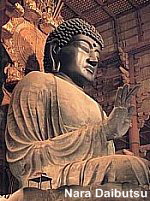 HISTORICAL SETTING. The Nara period begins with the relocation of the capital to Heijōkyō 平城京 (present-day Nara). The new Japanese capital was modeled after the Chinese capital of Chang'an 長安 (Jp. = Chōan), underscoring Japan's fascination with China’s Tang (Jp. = Tō 唐; + 618-907) culture, art, and architecture. The Nara era was marked by lavish court spending on Buddhist temples, stautes, art, and texts. During the period, Emperor Shomu 聖武 (Shōmu; reigned +724 to 749) ordered the establishment of a nationwide system of provincial monasteries (kokubunji 国分寺) and nunneries (kokubun-niji 国分尼寺), with each provincial temple directly answerable to Todaiji (Tōdaiji) Temple 東大寺 in Nara, the head of all state-established temples. Government-sponsored workshops Zobussho (Zōbussho) 造仏所 were established to make Buddhist statuary, mostly bronze, but also clay, lacquer, and wood. The most important government workshop, as one might expect, was located at Todaiji Temple, where a gigantic bronze Big Buddha (Daibutsu) statue was unveiled in +752 under the direction of Kuninaka no Kimimaro 国中公麻呂, the Daibusshi who managed hundreds of artisans to complete the project. The colossal statue was inspired by a giant effigy carved in the cliffs of Longmen 竜門 near the Chinese capital in Chang'an 長安 (Jp: Chōan, Choan). Japan’s newly established provincial temples, however, were furnished with smaller statues reproduced mostly from Korean and Chinese models. HISTORICAL SETTING. The Nara period begins with the relocation of the capital to Heijōkyō 平城京 (present-day Nara). The new Japanese capital was modeled after the Chinese capital of Chang'an 長安 (Jp. = Chōan), underscoring Japan's fascination with China’s Tang (Jp. = Tō 唐; + 618-907) culture, art, and architecture. The Nara era was marked by lavish court spending on Buddhist temples, stautes, art, and texts. During the period, Emperor Shomu 聖武 (Shōmu; reigned +724 to 749) ordered the establishment of a nationwide system of provincial monasteries (kokubunji 国分寺) and nunneries (kokubun-niji 国分尼寺), with each provincial temple directly answerable to Todaiji (Tōdaiji) Temple 東大寺 in Nara, the head of all state-established temples. Government-sponsored workshops Zobussho (Zōbussho) 造仏所 were established to make Buddhist statuary, mostly bronze, but also clay, lacquer, and wood. The most important government workshop, as one might expect, was located at Todaiji Temple, where a gigantic bronze Big Buddha (Daibutsu) statue was unveiled in +752 under the direction of Kuninaka no Kimimaro 国中公麻呂, the Daibusshi who managed hundreds of artisans to complete the project. The colossal statue was inspired by a giant effigy carved in the cliffs of Longmen 竜門 near the Chinese capital in Chang'an 長安 (Jp: Chōan, Choan). Japan’s newly established provincial temples, however, were furnished with smaller statues reproduced mostly from Korean and Chinese models.
In the subsequent Heian era, the Zobussho were replaced by temple-run and independent workshops (Bussho 仏所), and Japan’s own indigenous sculptural style begins to emerge. Bronze, clay, and dry lacquer statues were made in great number, with wood statuary still somewhat overshadowed by these other materials (see Glossary of Materials & Techniques for Making Statues). The extant Buddhist statuary of the Nara Era is commonly referred to as classical. It reflected a matured sense of the artistic styles of T’ang China, which translated into fuller body modeling (with attention to the entire piece in the round, from front, back, and sides), more natural drapery, and a greater sense of movement. See the Nara Era Photo Tour for many examples.
  Kuninaka no Muraji Kimimaro Kuninaka no Muraji Kimimaro
国中連公麻呂 (d. +774). Also known as Kuninaka no Kimimaro 国中公麻呂. He served as the Daibusshi (master sculptor) at Todaiji (Tōdaiji) Temple 東大寺 and supervised the construction of the temple’s giant bronze statue of Birushana Buddha, which was unveiled around +752 and was perhaps the world’s largest bronze statue in its day. Kuninaka was the grandson of a family from Korea's Paekche (Jp. = Kudara 百済) Kingdom that had immigrated to Japan sometime after Paekche's defeat by Korea's Silla Dynasty (Jp. = Shiragi 新羅) in +660. Kuninaka is also credited with directing various construction projects at Hokkeiji Temple 法華寺, Yakushiji Temple 薬師寺 and Ishiyamadera 石山寺, all important Nara-period temples.
Representative Work of Nara Period. Todaiji (Tōdaiji) Temple 東大寺 in Nara even today maintains many exemplary statues from the Nara period, including statues made of bronze, clay, dry lacquer, and wood.

39 Photos of
Buddhist Statues
from Japan’s Nara Era.
Please see Nara Era Photo Tour
Says the Kimbell Art Museum: “In the Early Nara Period, the stern face softened and was replaced by a gentle, pure, childlike expression. The body became more naturally rounded to suggest a soft fleshiness......In addition, some sculptures of the Early Nara Period exhibit the fresh, more advanced features characteristic of China’s Sui to Early T’ang (618-ca. 907) Periods, such as the well-balanced compositions and naturalistic proportions and clothing.” <end quote from museum catalog, page 22, entitled The Great Age of Japanese Buddhist Sculpture (AD 300 - 1300) .> .>
Says the Encyclopædia Britannica: “The late Nara period shows a stylistic shift, probably imitating a continental trend, toward more mannered depictions of drapery and a more stolid, fleshy form, conveying a brooding feeling. Typical is the rendering of a tight-fitting garment at the thighs of a subject, with drapery elsewhere carved in evenly spaced, concentric waves.” In another story, Britannica says this about the early Heian period (+794 - 897): “Buddhist statues are mostly columnar icons, erect, symmetrical, and perfectly balanced, carved from single blocks of wood (editor: see Ichiboku) and displaying a keen sense of material, with no attempt to smooth over cuts of the knife. The massive bodies are corpulent and heavy, with almost flabby chests, large round faces, large lips, wide noses, and wide eyes. These parts are simplified to an almost geometric formula. Size and simple contours give the sculpture a forbidding monumentality.” <end quotes from Britannica>
|